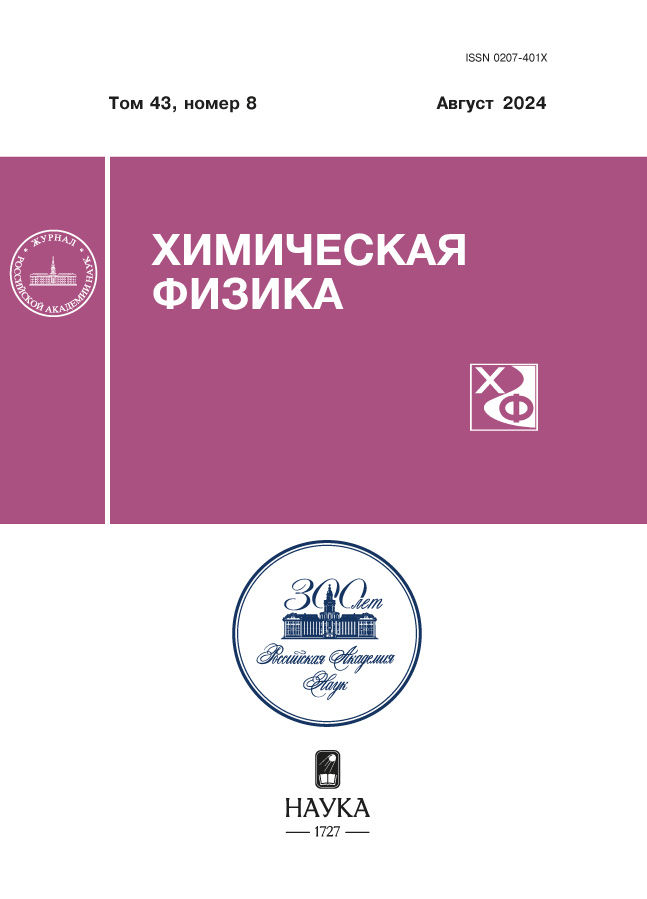Influence of mechanical activation and impurity gas release on the macrokinetics of combustion and the product structure in the Ti–C–B system for pressed compacts and granulated mixtures
- Authors: Vasilyev D.S.1, Seplyarskii B.S.1, Kochetov N.A.1
-
Affiliations:
- Merzhanov Institute of Structural Macrokinetics and Materials Science, Russian Academy of Sciences
- Issue: Vol 43, No 8 (2024)
- Pages: 31-41
- Section: Combustion, explosion and shock waves
- URL: https://cijournal.ru/0207-401X/article/view/681882
- DOI: https://doi.org/10.31857/S0207401X24080045
- ID: 681882
Cite item
Abstract
The influence of mechanical activation of the system 100−x(Ti+C)+x(Ti+2B) on the character of combustion of samples with different macrostructure: pressed compacts with relative density of 0.53-0.6 and bulk density granules of 0.6–1.6 mm size has been investigated. It was found that mechanical activation of powders leads to a gradual decrease in the combustion rate of pressed samples with increasing Ti+2B content in the mixtures (a descending dependence), and increasing Ti+2B content in compacts from nonactivated powders leads to an increase in the combustion rate (an ascending dependence). The obtained results contradict the theoretical ideas about the influence of mechanical activation on the combustion process, according to which the combustion rate should increase. One of the important factors influencing the change in the combustion rate is the release of impurity gases. For the first time the influence of mechanical activation on the character of combustion of granular mixtures was experimentally determined. It was found that the combustion rates of granular mixtures are higher than those of powder mixtures for all the compositions studied. It is shown that granulated mixtures from activated powder have a combustion rate on average 3 times higher compared to granules from nonactivated powder, and the dependence of the combustion rate on the mass content of Ti+2B has a local minimum, which is probably related to the peculiarities of the mechanical activation process.
Full Text
About the authors
D. S. Vasilyev
Merzhanov Institute of Structural Macrokinetics and Materials Science, Russian Academy of Sciences
Author for correspondence.
Email: d.s.vasilyev@mail.ru
Russian Federation, Chernogolovka
B. S. Seplyarskii
Merzhanov Institute of Structural Macrokinetics and Materials Science, Russian Academy of Sciences
Email: seplb1@mail.ru
Russian Federation, Chernogolovka
N. A. Kochetov
Merzhanov Institute of Structural Macrokinetics and Materials Science, Russian Academy of Sciences
Email: d.s.vasilyev@mail.ru
Russian Federation, Chernogolovka
References
- A.G. Merzhanov, A.S. Mukasyan, Solid flame combustion. Moscow: Torus Press, (2007).
- E.A. Levashov, A.S. Mukasyan, A.S. Rogachev, et al., Int. Mater. Rev. 62, 4 (2017). https://doi.org/10.1080/09506608.2016.1243291
- H.H. Nersisyan, J.H. Lee, J.R. Ding, et al., Prog. Energy Combust. Sci. 63, (2017). https://doi.org/10.1016/j.pecs.2017.07.002
- K. Morsi, J. Mater. Sci. 47, 1 (2012). https://doi.org/10.1007/s13632-013-0071-y
- E.A. Levashov, V.I. Kosayanin, L.M. Krukova, et al., Surf. Coat. Technol. 92, 1–2 (1997). https://doi.org/10.1016/S0257-8972(96)03083-6
- F. Yang, Q. Qin, T. Shi, et al., Ceram. Int. 45, 4 (2019). https://doi.org/10.1016/j.ceramint.2018.11.096
- D. Vallauri, I.A. Adrian, A. Chrysanthou, J. Eur. Ceram. 28, 8 (2008). https://doi.org/10.1016/j.jeurceramsoc.2007.11.011
- Y. Zhang, B. Wang, B. Dong, et al., Tribol. Lett. 71, 84 (2023). https://doi.org/10.1007/s11249-023-01756-x
- N. Pugacheva, D. Kryuchkov, T. Bykova, et al., Materials. 16, 8 (2023). https://doi.org/10.3390/ma16083204
- M. Ziemnicka-Sylwester, Materials. 6, 5 (2013). https://doi.org/10.3390/ma6051903
- Y.F. Yang, H.Y. Wang, Y.H. Liang et al., Mater. Sci. Eng. A. 445–446, 15 (2007). https://doi.org/10.1016/j.msea.2006.09.062
- N.M. Rubtsov, B.S. Seplyarskii, M.I. Alymov, Ignition and Wave Processes in Combustion of Solids. Springer International Publishing AG, Cham. Switzerland, (2017).
- N.A. Kochetov, B.S. Seplyarsky, Russ. J. Phys. Chem. B. 16 1 (2022). https://doi.org/10.1134/S1990793122010079
- V.N. Nikogosov, G.A. Nersesyan, V.A. Sherbakov, et al., Int. J. Self-Propag. High-Temp. Synth. 8, 3 (1999).
- A.A. Belyaev, B.S. Ermolaev, Russ. J. Phys. Chem. B 17, (2023). https://doi.org/10.1134/S199079312304022X
- B.S. Seplyarsky, N.I. Abzalov, R.A. Kochetkov, et al. Russ. J. Phys. Chem. B 15, 2 (2021). https://doi.org/10.1134/s199079312102010x
- B.S. Seplyarsky R.A. Kochetkov, T.G. Lisina, Combust. Explos. Shock Waves. 55, 3 (2019). https://doi.org/10.1134/S0010508219030079
- A.S. Rogachev, Russ. Chem. Rev. 88, 9 (2019). https://doi.org/10.1070/RCR4884
- M.A. Korchagin, Combust. Explos. Shock Waves. 51, (2015). https://doi.org/10.1134/S0010508215050093
- N.A. Kochetov, B.S. Seplyarsky, Russ. J. Phys. Chem. B 14, 5 (2020). https://doi.org/10.1134/S199079312005005X
- A. Matveev, V. Promakhov, P. Nikitin, et al., Materials. 15, 7 (2022). https://doi.org/10.3390/ma15072668
- M.A. Korchagin, A.I. Gavrilov, V.E. Zarko, et al., Combust. Explos. Shock Waves. 53, 6 (2017). https://doi.org/10.1134/S0010508217060077
- N.A. Kochetov, Combust. Explos. Shock Waves. 58, 2 (2022). https://doi.org/10.1134/S0010508222020058
- N.A. Kochetov, B.S. Seplyarskii, A.S. Shchukin, Combust. Explos. Shock Waves. 55, (2019). https://doi.org/10.1134/S0010508219030080
- F. Maglia, U. Anselmi-Tamburini, C. Deidda et al., J. Mater. Sci. 39, (2004). https://doi.org/10.1023/b:jmsc.0000039215.28545.2f
- Y.V. Bogatov, V.A. Shcherbakov, Russ. J. Non-Ferr. 62, (2021). https://doi.org/10.3103/S1061386223030032
- N. A. Kochetov, S. G. Vadchenko, Combust. Explos. Shock Waves. 51, (2015). https://doi.org/10.1134/S0010508215040103
- N.A. Kochetov, A.E. Sytschev, Mater. Chem. Phys. 257, (2021). https://doi.org/10.1016/j.matchemphys.2020.123727
- A.P. Aldushin, T.M. Martemyanova, A.G. Merzhanov et al., Combust. Explos. Shock Waves. 8, 2 (1972). https://doi.org/10.1007/BF00740444
- B.S. Seplyarskii, Dokl. Phys. Chem. 396, (2004). https://doi.org/10.1023/B:DOPC.0000033505.34075.0a
- B.S. Seplyarskii, R.A. Kochetkov, Int. J. Self-Propag. High-Temp. Synth. 26, 2 (2017). https://doi.org/10.3103/S106138621702011X
- S. Vorotilo, V. Kiryukhantsev-Korneev, B.S. Seplyarskii, et al., Crystals. 10, 5 (2020). https://doi.org/10.3390/cryst10050412
- B.S. Seplyarskii, R.A. Kochetkov, T.G. Lisina, et al., Combust. Explos. Shock Waves. 57, 1 (2021). https://doi.org/10.1134/S001050822101007X
- B.S. Seplyarskii, R.A. Kochetkov, T.G. Lisina, et al. Combust. Explos. Shock Waves. 57, (2021). https://doi.org/10.15372/FGV20210308
Supplementary files


















